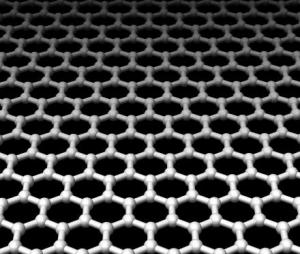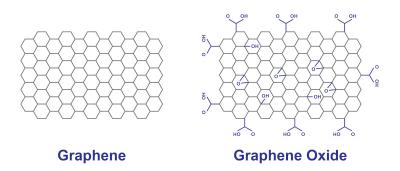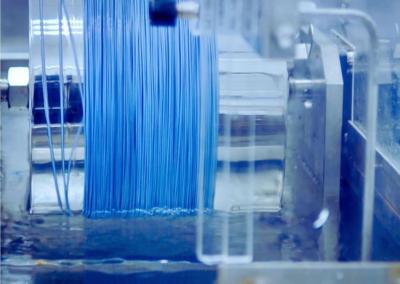Graphene Oxide: Introduction and Market News
What is Graphene Oxide?
Graphene is a material made of carbon atoms that are bonded together in a repeating pattern of hexagons. Graphene is so thin that it is considered two dimensional. Graphene is considered to be the strongest material in the world, as well as one of the most conductive to electricity and heat. Graphene has endless potential applications, in almost every industry (like electronics, medicine, aviation and much more).

As graphene is expensive and relatively hard to produce, great efforts are made to find effective yet inexpensive ways to make and use graphene derivatives or related materials. Graphene oxide (GO) is one of those materials - it is a single-atomic layered material, made by the powerful oxidation of graphite, which is cheap and abundant. Graphene oxide is an oxidized form of graphene, laced with oxygen-containing groups. It is considered easy to process since it is dispersible in water (and other solvents), and it can even be used to make graphene. Graphene oxide is not a good conductor, but processes exist to augment its properties. It is commonly sold in powder form, dispersed, or as a coating on substrates.

Graphene oxide is synthesized using four basic methods: Staudenmaier, Hofmann, Brodie and Hummers. Many variations of these methods exist, with improvements constantly being explored to achieve better results and cheaper processes. The effectiveness of an oxidation process is often evaluated by the carbon/oxygen ratios of the graphene oxide.
Graphene oxide uses
Graphene Oxide films can be deposited on essentially any substrate, and later converted into a conductor. This is why GO is especially fit for use in the production of transparent conductive films, like the ones used for flexible electronics, solar cells, chemical sensors and more. GO is even studied as a tin-oxide (ITO) replacement in batteries and touch screens.
Graphene Oxide has a high surface area, and so it can be fit for use as electrode material for batteries, capacitors and solar cells. Graphene Oxide is cheaper and easier to manufacture than graphene, and so may enter mass production and use sooner.
GO can easily be mixed with different polymers and other materials, and enhance properties of composite materials like tensile strength, elasticity, conductivity and more. In solid form, Graphene Oxide flakes attach one to another to form thin and stable flat structures that can be folded, wrinkled, and stretched. Such Graphene Oxide structures can be used for applications like hydrogen storage, ion conductors and nanofiltration membranes.
Graphene oxide is fluorescent, which makes it especially appropriate for various medical applications. bio-sensing and disease detection, drug-carriers and antibacterial materials are just some of the possibilities GO holds for the biomedical field.
Buy Graphene Oxide
Graphene oxide is relatively affordable and easy to find, with many companies that sell it. It does, however, get confusing since different companies offer products that vary in quality, price, form and more - making the choice of a specific product challenging. If you are interested in buying GO, contact Graphene-Info for advisement on the right GO for your exact needs!
Further reading
- Introduction to graphene
- Graphene company database
- Graphene batteries
- Graphene supercapacitors
- The Graphene Handbook, our very own guide to the graphene market
- Graphene Oxide Market Report
Graphene oxide can help PEDOT conduct electricity, to enable efficient plastic supercapacitors
PEDOT, short for poly(3,4-ethylenedioxythiophene), is a flexible, transparent film often applied to the surfaces of photographic films and electronic components to protect them from static electricity. It is also found in touch screens, organic solar cells and electrochromic devices, such as smart windows. However, PEDOT’s potential for energy storage has been limited because commercially available PEDOT materials lack the electrical conductivity and surface area needed to hold large amounts of energy.
An example of how EDOT monomer vapors react with a droplet of graphene oxide and ferric chloride to form PEDOT nanofibers. Image credit: UCLA
UCLA chemists have addressed these challenges with an innovative method that makes use of graphene oxide to control the morphology of PEDOT to grow nanofibers precisely. These nanofibers exhibit exceptional conductivity and expanded surface area, both of which are crucial for enhancing the energy storage capabilities of PEDOT. This approach demonstrates the potential of PEDOT nanofibers for supercapacitor applications.
Art and science combine to create graphene-enhanced clay artwork
Researchers at the National University of Singapore (NUS), and Deliarts recently presented an interdisciplinary approach combining materials science, ultrasonication, artistic expression, and curatorial practice to develop graphene-enhanced ceramics, improving strength and aesthetics. The focus of the approach was incorporating graphene oxide (GO) into kaolin clay and exploring its effects on material properties.
Image taken from: technologynetworks.com, Credit: Daria Andreeva, National University of Singapore, and Delia Prvački, Deliarts Pte Ltd.
In recent years, scientists have been adding GO to ceramic slurries — consisting of particles of kaolin clay or other materials dispersed in water — to make fired ceramics more durable and resistant to thermal shock. The team adapted this technique by using ultrasound to better mix the GO into kaolin slurries. They adjusted GO concentration and ultrasound exposure time to find the conditions that most enhanced the resulting ceramics’ strength and heat resistance. The team also collaborated with artist-in-residence Delia Prvački, who created works from the new ceramic material that are on display at the National University of Singapore Museum.
Graphene oxide and chitosan sponge for ultrafast and precise recovery of gold from electronic waste
Researchers at the National University of Singapore, working with colleagues from Manchester University and Guangdong University of Technology, have developed a sponge-like material made of graphene oxide and chitosan, that can be used to extract gold from electronic waste. In their recent study, the research team describes how they made their sponge and how well it worked during testing.
Previous research has shown that removing gold, silver and other metals from electronic equipment that is no longer useful, as a way to recycle such materials, is a difficult task that often results in low yields and the generation of a variety of toxic pollutants. In this new work, the team has found a way to remove the gold in a way that is cheaper and cleaner than conventional methods and much more efficient as well.
Memsift Innovations acquires graphene membrane technology from Singapore’s Ngee Ann Polytechnic
Singapore-based Memsift Innovations has entered into a technology transfer agreement with Singapore’s Ngee Ann Polytechnic on an innovative graphene membrane technology.
It was explained that the technology, featuring graphene oxide-based hollow fiber ultrafiltration and nanofiltration membranes, was developed based on over a decade of research and development. The ultrafiltration technology utilizes a graphene oxide-block copolymer composite renowned for its exceptional chemical and thermal stability, making it ideal for harsh industrial applications. Its unique surface chemistry forms a protective water layer that effectively prevents fouling. The nanofiltration technology employs a robust single-layer modified graphene oxide membrane with synthetic water channels, enhancing selectivity and permeability. This enables efficient molecular-level separation and differentiation between monovalent and multivalent ions.
Researchers develop fabrication strategy for improved graphene aerogels
While graphene aerogels have advantageous properties like extremely low weight, high porosity and good electrical conductivity, engineers who tried to use them to develop pressure sensors have encountered some difficulties.
Image credit: Nano Letters 2024
Specifically, many of these materials have an intrinsically stiff microstructure, which poses limits on their strain sensing capabilities. Researchers from Xi'an Jiaotong University, Northumbria University, UCLA, University of Alberta and other institutes recently introduced a new fabrication strategy for synthesizing aerogel metamaterials to overcome this limitation. This strategy fabricates a durable graphene oxide-based aerogel metamaterial that exhibits a remarkable sensitivity to human touch and motion.
Researchers track the quality of graphene oxide during long-term storage
A research team from Skoltech, MIPT, Emanuel Institute of Biochemical Physics of Russian Academy of
Sciences, and other scientific organizations recently conducted a study to determine which conditions are the most suitable for storing graphene oxide.
The results showed that the most optimal conditions for graphene oxide, when its properties will not change, are low temperatures and a lack of light.
Researchers develop improved hydrogen ion barrier films using pore-free graphene oxide membranes
Researchers from Kumamoto University and Hiroshima University have announced a significant development in hydrogen ion barrier films using graphene oxide (GO) without internal pores. This approach could be beneficial for protective coatings for various applications.
In their study, the research team successfully synthesized and developed a pore-free GO (Pf-GO) membrane with controlled oxygen functional groups. Traditionally, GO has been known for its high ionic conductivity, which made it challenging to use as an ion barrier. However, by eliminating the internal pores, the team created a material with dramatically improved hydrogen ion barrier properties.
New technique enables ultrafast 2D nanosheet assembly
Researchers from Nagoya University, Osaka University and National Taiwan University recently developed a method for the high-speed, large-area deposition of two-dimensional (2D) materials, including oxides, graphene oxide, and boron nitride. This innovative technique, known as the "spontaneous integrated transfer method," was discovered by chance; however, it could significantly improve the production of nanosheets.
Traditionally, methods like chemical vapor deposition (CVD) and the Langmuir-Blodgett (LB) technique have been employed for nanosheet fabrication. However, these methods have significant disadvantages, including difficulties in achieving uniform, large-area deposition and complications in the substrate transfer process. Aiming to develop a more effective deposition technology, the research team discovered a fascinating phenomenon completely by chance: when nanosheets get wet, they spontaneously align themselves on the surface of water, forming dense films within a mere 15 seconds. This process, termed the "spontaneous spreading phenomenon," suggested a more effective deposition technology.
Chang Robotics and Northwestern University’s INVO Lab introduce new graphene-enhanced packaging
Chang Robotics, an engineering company, and Northwestern University’s INVO Lab have announced a joint venture aimed at reducing contamination from microplastics and poly-fluoroalkyl substances (PFAS) in the US food supply.
This collaboration has led to the development of GOEco, an initiative that shows that very small amounts of graphene oxide can be infused into paper products or compostable packaging materials to replace plastic and PFAS. GOEco’s primary goal is to replace the widespread use of plastics in food packaging, such as paper plates and disposable utensils. The patent-pending technology helps enhance the environmental friendliness of disposable tableware without compromising functionality.
Researchers propose chromatography-like separation mechanism with UV-rGO membranes
Researchers from Pacific Northwest National Laboratory have found that reducing graphene oxide (GO) membranes with ultraviolet (UV) light alters the oxygen functional groups on the GO surface. This modification results in a different, chromatography-like separation mechanism that is selective for charge rather than size.
Image credit: Chemical Engineering Journal
Developing efficient, selective, and scalable separations for critical materials, including lithium and magnesium, is essential to meeting the increasing demands for clean energy technologies and alleviating challenges with domestic supply chains. GO membranes have shown promise for separating ions from mixed solutions based on size.
Pagination
- Page 1
- Next page








